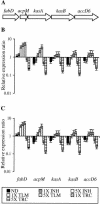Signature gene expression profiles discriminate between isoniazid-, thiolactomycin-, and triclosan-treated Mycobacterium tuberculosis
- PMID: 12936993
- PMCID: PMC182614
- DOI: 10.1128/AAC.47.9.2903-2913.2003
Signature gene expression profiles discriminate between isoniazid-, thiolactomycin-, and triclosan-treated Mycobacterium tuberculosis
Abstract
Genomic technologies have the potential to greatly increase the efficiency of the drug development process. As part of our tuberculosis drug discovery program, we used DNA microarray technology to profile drug-induced effects in Mycobacterium tuberculosis. Expression profiles of M. tuberculosis treated with compounds that inhibit key metabolic pathways are required as references for the assessment of novel antimycobacterial agents. We have studied the response of M. tuberculosis to treatment with the mycolic acid biosynthesis inhibitors isoniazid, thiolactomycin, and triclosan. Thiolactomycin targets the beta-ketoacyl-acyl carrier protein (ACP) synthases KasA and KasB, while triclosan inhibits the enoyl-ACP reductase InhA. However, controversy surrounds the precise mode of action of isoniazid, with both InhA and KasA having been proposed as the primary target. We have shown that although the global response profiles of isoniazid and thiolactomycin are more closely related to each other than to that of triclosan, there are differences that distinguish the mode of action of these two drugs. In addition, we have identified two groups of genes, possibly forming efflux and detoxification systems, through which M. tuberculosis may limit the effects of triclosan. We have developed a mathematical model, based on the expression of 21 genes, which is able to perfectly discriminate between isoniazid-, thiolactomycin-, or triclosan-treated M. tuberculosis. This model is likely to prove invaluable as a tool to improve the efficiency of our drug development programs by providing a means to rapidly confirm the mode of action of thiolactomycin analogues or novel InhA inhibitors as well as helping to translate enzyme activity into whole-cell activity.
Figures





Similar articles
-
Isoniazid affects multiple components of the type II fatty acid synthase system of Mycobacterium tuberculosis.Mol Microbiol. 2000 Nov;38(3):514-25. doi: 10.1046/j.1365-2958.2000.02145.x. Mol Microbiol. 2000. PMID: 11069675
-
The role of KasA and KasB in the biosynthesis of meromycolic acids and isoniazid resistance in Mycobacterium tuberculosis.Tuberculosis (Edinb). 2002;82(4-5):149-60. doi: 10.1054/tube.2002.0333. Tuberculosis (Edinb). 2002. PMID: 12464486
-
Inhibition of InhA, the enoyl reductase from Mycobacterium tuberculosis, by triclosan and isoniazid.Biochemistry. 2000 Jul 4;39(26):7645-50. doi: 10.1021/bi0008940. Biochemistry. 2000. PMID: 10869170
-
Triclosan and its derivatives as antimycobacterial active agents.Eur J Pharm Sci. 2018 Mar 1;114:318-331. doi: 10.1016/j.ejps.2017.12.013. Epub 2017 Dec 23. Eur J Pharm Sci. 2018. PMID: 29277667 Review.
-
Overview on mechanisms of isoniazid action and resistance in Mycobacterium tuberculosis.Infect Genet Evol. 2016 Nov;45:474-492. doi: 10.1016/j.meegid.2016.09.004. Epub 2016 Sep 6. Infect Genet Evol. 2016. PMID: 27612406 Review.
Cited by
-
Action of Dicumarol on Glucosamine-1-Phosphate Acetyltransferase of GlmU and Mycobacterium tuberculosis.Front Microbiol. 2019 Aug 20;10:1799. doi: 10.3389/fmicb.2019.01799. eCollection 2019. Front Microbiol. 2019. PMID: 31481936 Free PMC article.
-
2-aminoimidazoles potentiate ß-lactam antimicrobial activity against Mycobacterium tuberculosis by reducing ß-lactamase secretion and increasing cell envelope permeability.PLoS One. 2017 Jul 27;12(7):e0180925. doi: 10.1371/journal.pone.0180925. eCollection 2017. PLoS One. 2017. PMID: 28749949 Free PMC article.
-
A Novel TetR-Like Transcriptional Regulator Is Induced in Acid-Nitrosative Stress and Controls Expression of an Efflux Pump in Mycobacteria.Front Microbiol. 2017 Oct 23;8:2039. doi: 10.3389/fmicb.2017.02039. eCollection 2017. Front Microbiol. 2017. PMID: 29109706 Free PMC article.
-
Transcriptional Adaptation of Drug-tolerant Mycobacterium tuberculosis During Treatment of Human Tuberculosis.J Infect Dis. 2015 Sep 15;212(6):990-8. doi: 10.1093/infdis/jiv149. Epub 2015 Mar 11. J Infect Dis. 2015. PMID: 25762787 Free PMC article.
-
Drug discovery using chemical systems biology: repositioning the safe medicine Comtan to treat multi-drug and extensively drug resistant tuberculosis.PLoS Comput Biol. 2009 Jul;5(7):e1000423. doi: 10.1371/journal.pcbi.1000423. Epub 2009 Jul 3. PLoS Comput Biol. 2009. PMID: 19578428 Free PMC article.
References
-
- Alland, D., I. Kramnik, T. R. Weisbrod, L. Otsubo, R. Cerny, L. P. J. W. Miller, and B. R. Bloom. 1998. Identification of differentially expressed mRNA in prokaryotic organisms by customized amplification libraries (DECAL)—the effect of isoniazid on gene expression in Mycobacterium tuberculosis. Proc. Natl. Acad. Sci. USA 95:13227-13232. - PMC - PubMed
-
- Banerjee, A., E. Dubnau, A. Quemard, A. S. Balasubramanian, K. S. Um, T. Wilson, D. Collins, G. W. de Lisle, and W. R. Jacobs. 1994. inhA, a gene encoding a target for isoniazid and ethionamide in Mycobacterium tuberculosis. Science 263:227-230. - PubMed
-
- Barry, C. E., M. Wilson, R. Lee, and G. K. Schoolnik. 2000. DNA microarrays and combinatorial chemical libraries: tools for the drug discovery pipeline. Int. J. Tuberc. Lung Dis. 4:S189-S193. - PubMed
-
- Betts, J. C. 2002. Transcriptomics and proteomics: tools for the identification of novel drug targets and vaccine candidates for tuberculosis. IUBMB Life 53:239-242. - PubMed
MeSH terms
Substances
LinkOut - more resources
Full Text Sources
Medical
Molecular Biology Databases
Research Materials

